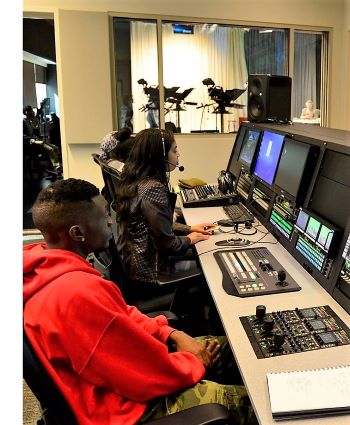
Undergraduate program formally launches in the fall 2021
Tuesday, January 12, 2021
A digital media studies degree will be added to the University of Maryland Eastern Shore’s roster of undergraduate majors beginning in the fall 2021.
The Department of English and Modern Languages currently offers courses in production and programming of audio and video as well as interviewing and broadcast performance that until now has qualified as a minor in digital media studies at graduation.
A curriculum expansion that received state regulatory approval in late 2020 will “produce graduates who will be viable candidates for entry-level media positions across a broad cross-section of the (communications) industry … such as (a) production assistant in a broadcast newsroom, an account assistant in a public relations firm, a videographer in a commercial production house or a social media coordinator.”
In a letter accompanying the proposal, President Heidi M. Anderson wrote the university “hopes to afford underrepresented students an opportunity to pursue a structured yet dynamic educational program that focuses on the media and entertainment” industries.
UMES alumni who took media studies courses as a minor have found employment with NBC’s “Early Today” show in New York, in standards and practices at OWN (the Oprah Winfrey Network) and in promotion at FOX Sports, both in Los Angeles; on a field crew at C-SPAN, producing a lifestyle show at WJLA and directing live news at WTTG, all in the nation’s capital.
The university is poised to produce “a well-qualified, diverse pool of applicants who can participate at the highest level of decision-making with global media companies,” Anderson said.
UMES’ Engineering and Aviation Science Complex, which opened in early 2016, has $3 million in digital audio and video production equipment, industry-specific software, a graphics lab, and multiple audio and video studio facilities.
“The building was designed to bring many of UMES’ technology programs under one roof,” said Marilyn Buerkle, an instructor and former TV broadcaster who helped shape the expanded sequence of courses. “We believe (these) state-of-the-art resources will serve as a valuable recruitment tool, ensuring the success of the new degree program.”
Buerkle and faculty colleagues anticipate UMES students who will be sophomores this fall and currently earning digital media credit hours may opt to earn a Bachelor of Arts degree in the field. By year four, the hope is UMES will produce five-to-10 graduates annually, she said.
In addition to fulfilling a 14-class, 42-credit “core curriculum,” digital media studies majors also must take two foreign language courses and earn 18 digital-media elective credits, which could include off-campus internships.
Buerkle and one other fulltime faculty member teach digital media courses alongside adjunct instructors who are fulltime professional communicators. As enrollment grows, Buerkle said the state-approved plan anticipates a faculty member will serve as program “coordinator,” and that several fulltime instructors “who would each bring specific expertise” will be hired.
“We expect specialists to have experience in journalism / public relations / social media as well as film / video and audio production, graphic / web design and animation,” Buerkle said.
Having a digital media studies program, Anderson noted, “will position UMES well to expand the knowledge and training of professionals who serve an ever-changing industry and supports our goal to offer academic programs that prepare graduates who can address challenges on the Eastern Shore, the state, the nation and the world.”
Other UMES faculty members who participated in creating the digital media studies curriculum were Dr. Amy Hagenrater-Gooding, Dr. Cynthia Cravens, Joseph A. Davis and Dr. Dean Cooledge, chairman of the Department of English and Modern Languages.

